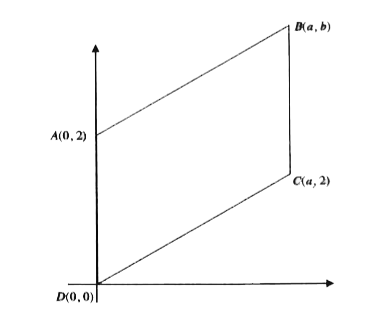Suppose ABCD is a quadrilateral such that the coordinates of A, B and C are (1,3)(−2,6)and(5,−8) respectively. For what choices of coordinates of D will make ABCD a trapezium ?
Step by step video & image solution for Suppose ABCD is a quadrilateral such that the coordinates of A, B and C are (1,3)(-2,6) and (5,-8) respectively. For what choices of coordinates of D will make ABCD a trapezium ? by Maths experts to help you in doubts & scoring excellent marks in Class 11 exams.
Updated on:21/07/2023Similar Questions
Knowledge Check
ABCD is a rectangle in the clockwise direction. The coordinates of A are (1, 3) and of C are (5, 1), vertices B and D lie on the line y=2x+c, then the coordinates of D are
A(2, 0)B(4, 4)C(0, 2)D(2, 4)In the rectangular coordinate system shown, ABCD is a parallogram. If the coordinates of the points A,B,C and D are (0,2),(a,b),(a,2) and (0,0), respectively, then b =
 A0B2C3D4
A0B2C3D4
A ,B and C are the points (2,0),(5,0)and(5,3) respectively. Find coordinates of D such that ABCD is a square.
View SolutionA ,B and C are the points (2,0),(5,0)and(5,3) respectively. Find coordinates of D such that ABCD is a square.
View SolutionABCD is a parallelogram. If the coordinates of A, B, C are (2,3), (1,4)and (0,−2) respectively, find the coordinates of D.
View SolutionFind the area of quadrilateral ABCD, the co-ordinates of whose vertices are A(1, 2), B(6, 2), C(5, 3) and D(3,4).
View SolutionIn a quadrilateral ABCD, CO and DO are the bisectors of ∠C and ∠D respectively. Prove that ∠COD=12(∠A+∠B)
View SolutionIf A(−3,5),B(−2,−7),C(1,−8)andD(6,3) are the vertices of a quadrilateral ABCD find its area.
View Solution
